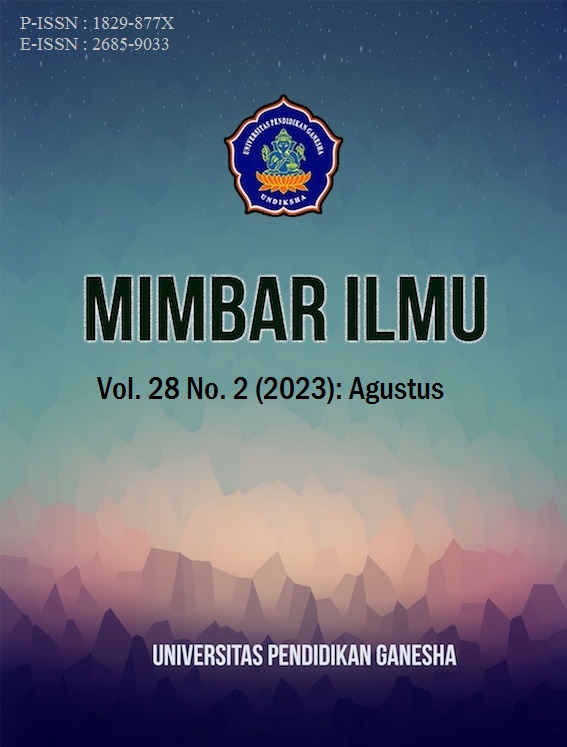Factors Influencing Interest in Continuing Use of e-Wallet Using the Technology Acceptance Model and Task-Technology FIT
DOI:
https://doi.org/10.23887/mi.v28i2.61228Keywords:
e-Wallet, TAM, TTF, Continuance Intention, PLS - SEMAbstract
An electronic wallet (e-Wallet) application allows users to make transactions electronically by storing user money on a server. The use of e-wallets is increasing daily, increasing the number of transactions and users. This research aims to analyze the factors related to the intention to reuse e-wallet applications so that they can contribute to the development of e-wallet applications. This quantitative research combined the Technology Acceptance Model and Task-Technology Fit models using the PLS-SEM method and SmartPLS software. Data was collected using a Likert scale questionnaire based on Google Forms. Data analysis technique using inferential statistical analysis. The research results obtained after testing the Outer Model, Inner Model, and Hypothesis Testing show that task characteristics, technological characteristics, task and technology suitability, and users' perceived usability significantly influence the intention to reuse e-wallet applications. The user's perceived ease of use factor does not significantly influence the intention to reuse the e-wallet application. Based on the results obtained, this study has a high predictive relevance value, thus confirming that the combination of the TAM and TTF models has an effective theoretical basis for analyzing the sustainable interest of e-wallet applications.
References
Adults, M. Y. (2020). Factors Influencing the Use of E-wallet as a Payment Method among Malaysian Young Adults. Journal of International Business and Management, 3(2), 1–11. https://doi.org/10.37227/jibm-2020-2-21.
Aji, H. M., Berakon, I., & Md Husin, M. (2020). COVID-19 and e-wallet usage intention: A multigroup analysis between Indonesia and Malaysia. Cogent Business and Management, 7(1). https://doi.org/10.1080/23311975.2020.1804181. DOI: https://doi.org/10.1080/23311975.2020.1804181
Arianita, A., & Anggarawati, S. (2023). Analysis Factor Affecting The Use Of Digital Payment With The Extended Utaut Model. The Manager Review, 5(1), 91–108. https://doi.org/10.33369/tmr.v5i1.29733. DOI: https://doi.org/10.33369/tmr.v5i1.29733
Cahyo, P. D., Nugraha, F. S., & Sugiarto, L. (2023). Perancangan UI/UX Aplikasi e-wallet “MyBank”. Jurnal Penelitian Sistem Informasi, 1(13), 9–22. https://doi.org/10.54066/jpsi.v1i3.615. DOI: https://doi.org/10.54066/jpsi.v1i3.615
Dishaw, M. T., & Strong, D. M. (1999). Extending The Technology Acceptance Model With Task-Technology Fit Constructs. 36, 9–21. DOI: https://doi.org/10.1016/S0378-7206(98)00101-3
Erawan, Y., & Pambudi, R. (2017). Analisis Penerimaan Dan Penggunaan Teknologi Google Drive Secara Berkelanjutan Pada Mahasiswa Fakultas Ekonomi Dan Bisnis Unika Atma Jaya Jakarta. Jurnal Akuntansi, 10(2), 191–205. https://doi.org/10.25170/jara.v10i2.46. DOI: https://doi.org/10.25170/jara.v10i2.46
Fadhulloh, M. M., & Ariyanto, B. (2022). Pengaruh Pendidikan dan Pengalaman Kerja Terhadap Kinerja Karyawan Di PT Elokuensi Harapan Bangsa. Jurnal Manajemen Saint Mary’S College, 8(10), 1–8. https://doi.org/10.3333/smc.v8i10.36. DOI: https://doi.org/10.24967/jmb.v8i2.1668
Fauzia, W. N., & Huda, M. (2022). Analisis Pengaruh Product Placement Pada Produk Kopi Luwak Dalam Sinetron “Ikatan Cinta” Terhadap Brand Awareness Melalui Brand Recall. JIMEK: Jurnal Ilmiah Mahasiswa Ekonomi, 5(1), 124–137. https://doi.org/10.30737/jimek.v5i1.2038.
Fitriani, D. (2018). Analisis pengaruh penggunaan teknologi informasi terhadap kinerja karyawan PT. Asuransi Jiwasraya Pontianak. Cogito Smart Journal, 4(1), 160–170. https://doi.org/10.31154/cogito.v4i1.110.160-170. DOI: https://doi.org/10.31154/cogito.v4i1.110.160-170
Giovanis, A. N., Binioris, S., & Polychronopoulos, G. (2012). An extension of TAM model with IDT and security/privacy risk in the adoption of internet banking services in Greece. EuroMed Journal of Business, 7(1), 24–53. https://doi.org/10.1108/14502191211225365. DOI: https://doi.org/10.1108/14502191211225365
Goodhue, D. L., & Thompson, R. L. (1995). Task-technology fit and individual performance. MIS Quarterly: Management Information Systems, 19(2), 213–233. https://doi.org/10.2307/249689. DOI: https://doi.org/10.2307/249689
Huang, C., Li, J., & Ross, K. W. (2007). Can internet video-on-demand be profitable? Computer Communication Review, 37(4), 133–144. https://doi.org/10.1145/1282427.1282396. DOI: https://doi.org/10.1145/1282427.1282396
I. A. Amrouni, K., A. Arshah, R., & J. Kadi, A. (2019). A Systematic Review: Factors Affecting Employees’ Adoption of E-government Using an Integration of UTAUT & TTF Theories. KnE Social Sciences, 2019, 54–65. https://doi.org/10.18502/kss.v3i22.5044. DOI: https://doi.org/10.18502/kss.v3i22.5044
John, D., Concepción, S. W., & Shahriar, A. (2013). Application of the Task-Technology Fit Model to Structure and Evaluate the Adoption of E-Books by Academics. Journal of the American Society for Information Science and Technology, 64(1), 48–64. https://doi.org/10.1002/asi. DOI: https://doi.org/10.1002/asi.22757
Juhri, K., & Dewi, C. K. (2017). Kepercayaan dan penerimaan layanan mobile money t-cash di Bandung dengan pendekatan Technology Acceptance Model (TAM). Probisnis. Probisnis (e-Journal, 10(1). https://doi.org/10.35671/probisnis.v10i1.503.
Kadim, A., & Sunardi, N. (2021). Financial Management System (QRIS) based on UTAUT Model Approach in Jabodetabek. International Journal of Artificial Intelligence Research, 6(1). https://doi.org/10.29099/ijair.v6i1.282. DOI: https://doi.org/10.29099/ijair.v6i1.282
Kumar, A., Dhingra, S., Batra, V., & Purohit, H. (2020). A Framework of Mobile Banking Adoption in India. Journal of Open Innovation: Technology, Market, and Complexity, 6(2), 40. https://doi.org/10.3390/JOITMC6020040. DOI: https://doi.org/10.3390/joitmc6020040
Lisana, L. (2021). Factors influencing the adoption of mobile payment systems in Indonesia. International Journal of Web Information Systems, 17(3), 0–10. https://doi.org/10.1108/IJWIS-01-2021-0004. DOI: https://doi.org/10.1108/IJWIS-01-2021-0004
Lu, H. P., & Yang, Y. W. (2014). Toward an understanding of the behavioral intention to use a social networking site: An extension of task-technology fit to social-technology fit. Computers in Human Behavior, 34, 323–332. https://doi.org/10.1016/j.chb.2013.10.020. DOI: https://doi.org/10.1016/j.chb.2013.10.020
Marliana, R. R. (2020). Partial Least Square-Structural Equation Modeling Pada Hubungan Antara Tingkat Kepuasan Mahasiswa Dan Kualitas Google Classroom Berdasarkan Metode Webqual 4.0. Jurnal Matematika, Statistika Dan Komputasi, 16(2), 174–186. https://doi.org/10.20956/jmsk.v16i2.7851. DOI: https://doi.org/10.20956/jmsk.v16i2.7851
Musyaffi, A. M., Johari, R. J., Rosnidah, I., Sari, D. A. P., Amal, M. I., Tasyrifania, I., Pertiwia, S. A., & Sutanti, F. D. (2021). Digital Payment during Pandemic: An Extension of the Unified Model of QR Code. Academic Journal of Interdisciplinary Studies, 10(6), 213–223. https://doi.org/10.36941/ajis-2021-0166. DOI: https://doi.org/10.36941/ajis-2021-0166
Nasution, H. F. (2016). Instrumen penelitian dan urgensinya dalam penelitian kuantitatif. Jurnal Ilmu Ekonomi Dan Keislaman, 4(1), 59–75. https://doi.org/10.24952/masharif.v4i1.721. DOI: https://doi.org/10.24952/masharif.v5i2.1434
Nurjani, N. P. S. (2018). Disrupsi industri 4.0; Implementasi, Peluang dan Tantangan Dunia Industri indonesia. Jurnal Ilmiah Vastuwidya, 1(2), 23–32. https://doi.org/10.47532/jiv.v1i2.23. DOI: https://doi.org/10.47532/jiv.v1i2.23
Oliveira, T., Faria, M., Thomas, M. A., & Popovič, A. (2014). Extending the understanding of mobile banking adoption: When UTAUT meets TTF and ITM. International Journal of Information Management, 34(5), 689–703. https://doi.org/10.1016/j.ijinfomgt.2014.06.004. DOI: https://doi.org/10.1016/j.ijinfomgt.2014.06.004
Osakwe, C. N., & Okeke, T. C. (2016). Facilitating mCommerce growth in Nigeria through mMoney usage: A preliminary analysis. Interdisciplinary Journal of Information, Knowledge, and Management, 11(June), 115–139. https://doi.org/10.28945/3456. DOI: https://doi.org/10.28945/3456
Pambudi, L. B. A., Rahagiyanto, A., & Suyoso, G. E. J. (2020). Implementasi QR code untuk efisiensi waktu pemesanan menu makanan dan minuman di restoran maupun kafe. BIOS: Jurnal Teknologi Informasi Dan Rekayasa Komputer.
Prameswari, A. (2021). Analisis Faktor-Faktor Yang Mempengaruhi Minat Konsumen Dalam Menggunakan Sistem Pembayaran E-Wallet (Studi Kasus Pada Mahasiswa UINSU Medan). Al-Sharf: Jurnal Ekonomi Islam, 2(2), 126–139. https://doi.org/10.56114/al-sharf.v2i2.191. DOI: https://doi.org/10.56114/al-sharf.v2i2.191
Putra, R. (2021a). Adoption of smart TV in UK and the moderating role of viewer classification. Jurnal Manajemen Pendidikan Dan Ilmu Sosial, 2(2), 989–1001. https://doi.org/10.4018/IJISSS.2019010101.
Putra, R. (2021b). Pengaruh Kepemimpinan Dan Kompetensi Terhadap Kinerja Karyawan Melalui Organizational Citizenship Behavior (Ocb) Karyawan Sebagai Variabel Intervening Pada Perusahaan Pt. Sawah Solok. Jurnal Manajemen Pendidikan Dan Ilmu Sosial, 2(2), 989–1001. https://doi.org/10.38035/jmpis.v2i2.767. DOI: https://doi.org/10.38035/jmpis.v2i2.767
Putra, R. (2021c). Perbandingan pendugaan parameter koefisien struktural model melalui SEM dan PLS-SEM. Jurnal Manajemen Pendidikan Dan Ilmu Sosial, 2(2), 989–1001. https://doi.org/10.29244/jmap.15.2.11-22. DOI: https://doi.org/10.29244/jmap.15.2.11-22
Radiansyah, R., Surachman, S., & Sunaryo, S. (2016). Faktor-Faktor yang Mempengaruhi Kesuksesan Penerimaan Teknologi Sistem Informasi Manajemen Pemerintah dan Dampaknya terhadap Kinerja Karyawan. Jurnal Aplikasi Manajemen, 14(4), 683–696. https://doi.org/10.18202/jam23026332.14.4.09. DOI: https://doi.org/10.18202/jam23026332.14.4.09
Riana, E. (2020). Implementasi Cloud Computing Technology dan Dampaknya Terhadap Kelangsungan Bisnis Perusahaan Dengan Menggunakan Metode Agile dan Studi Literatur. JURIKOM (Jurnal Riset Komputer), 7(3), 439–449. https://doi.org/10.30865/jurikom.v7i3.2192. DOI: https://doi.org/10.30865/jurikom.v7i3.2192
Rizaldi, M. A., Fathoni, M., & Yetty, F. (2021). Faktor Determinasi Minat Penggunaan Layanan LinkAja Syariah pada Masyarakat Jabodetabek. Journal of Sharia Economics,2(2), 120–140. https://doi.org/10.22373/jose.v2i2.1307. DOI: https://doi.org/10.22373/jose.v2i2.1307
Roziq, A., & Danurwenda, H. N. (2015). Pengaruh good corporate governance terhadap corporate social responsibility melalui risiko bisnis dan kinerja keuangan pada bank umum syariah di Indonesia. Jurnal Akuntansi Universitas Jember, 10(1), 90–109. https://doi.org/10.19184/jauj.v10i1.1248. DOI: https://doi.org/10.19184/jauj.v10i1.1248
Sari, R. K., Utama, S. P., & Zairina, A. (2021). The Effect of Online Shopping and E-Wallet on Consumer Impulse Buying. Asia Pacific Management and Business Application, 009(03), 231–242. https://doi.org/10.21776/ub.apmba.2021.009.03.3. DOI: https://doi.org/10.21776/ub.apmba.2021.009.03.3
Sarstedt, M., Ringle, C. M., & Hair, J. F. (2020). Handbook of Market Research. In Handbook of Market Research (Issue September). https://doi.org/10.1007/978-3-319-05542-8. DOI: https://doi.org/10.1007/978-3-319-05542-8
Siahaan, L., & Halawa, F. A. (2021). Pengaruh Pendidikan Dan Pengalaman Kerja Terhadap Kinerja Karyawan Pada CV. Permata Bakti Nusantara. Jurnal Manajemen Saint Mary’S College, 7(9), 1–9. https://doi.org/10.3333/smc.v7i9.31.
Syukriyyah, S., & Karyaningsih, K. (2023). Pengaruh Promosi Penjualan, Persepsi Manfaat Dan Persepsi Kemudahan Terhadap Minat Menggunakan E-Wallet Shopeepay Pada Mahasiswa Universitas Singaperbangsa Karawang. Transformasi Manageria: Journal Of Islamic Education Management, 3(1), 263–287. https://doi.org/10.47467/manageria.v3i2.2329. DOI: https://doi.org/10.47467/manageria.v3i2.2329
Uddin, M. N., Bokelmann, W., & Entsminger, J. S. (2014). Factors affecting farmers’ adaptation strategies to environmental degradation and climate change effects: A farm level study in bangladesh. Climate, 2(4), 223–241. https://doi.org/10.3390/cli2040223. DOI: https://doi.org/10.3390/cli2040223
Venkatesh, V., Morris, M. G., Davis, G. B., & Davis, F. D. (2003). User acceptance of information technology: Toward a unified view. MIS Quarterly: Management Information Systems, 27(3), 425–478. https://doi.org/10.2307/30036540. DOI: https://doi.org/10.2307/30036540
Widiyati, S., Listyani, T. T., & Rikawati. (2021). Identification of Obstacles in Using E-Wallet in Semarang. Admisi Dan Bisnis, 22(3), 1–12. DOI: https://doi.org/10.32497/keunis.v10i1.3070
Wijayanthi, I. M. (2019). Behavioral Intention of Young Consumers Towards E-Wallet Adoption: an Empirical Study Among Indonesian Users. Russian Journal of Agricultural and Socio-Economic Sciences, 85(1), 79–93. https://doi.org/10.18551/rjoas.2019-01.09. DOI: https://doi.org/10.18551/rjoas.2019-01.09
Wu, B., & Chen, X. (2017). Continuance intention to use MOOCs: Integrating the technology acceptance model (TAM) and task technology fit (TTF) model. Computers in Human Behavior, 67, 221–232. https://doi.org/10.1016/j.chb.2016.10.028. DOI: https://doi.org/10.1016/j.chb.2016.10.028
Wu, B., & Zhang, C. (2014). Empirical study on continuance intentions towards E-Learning 2.0 systems. Behaviour and Information Technology, 33(10), 1027–1038. https://doi.org/10.1080/0144929X.2014.934291. DOI: https://doi.org/10.1080/0144929X.2014.934291
Yusup, F. (2018). Uji validitas dan reliabilitas instrumen penelitian kuantitatif. Tarbiyah: Jurnal Ilmiah Kependidikan, 7(1). https://doi.org/10.18592/tarbiyah.v7i1.2100. DOI: https://doi.org/10.18592/tarbiyah.v7i1.2100
Zada, C., & Sopiana, Y. (2021). Penggunaan E-Wallet atau Dompet Digital sebagai Alat Transaksi Pengganti Uang Tunai Bagi UMKM di Kecamatan Banjarmasin Tengah. JIEP: Jurnal Ilmu Ekonomi Dan Pembangunan, 4(1), 251–268. https://doi.org/10.20527/jiep.v4i1.3556.
Zada, C., & Sopiana, Y. (2021). Penggunaan E-Wallet atau Dompet Digital sebagai Alat Transaksi Pengganti Uang Tunai Bagi UMKM di Kecamatan Banjarmasin Tengah. JIEP: Jurnal Ilmu Ekonomi Dan Pembangunan, 4(1), 251–268. https://doi.org/10.20527/jiep.v4i1.3556. DOI: https://doi.org/10.20527/jiep.v4i1.3556
Zhou, T., Lu, Y., & Wang, B. (2010). Integrating TTF and UTAUT to explain mobile banking user adoption. Computers in Human Behavior, 26(4), 760–767. https://doi.org/10.1016/j.chb.2010.01.013. DOI: https://doi.org/10.1016/j.chb.2010.01.013
Downloads
Published
How to Cite
Issue
Section
License
Copyright (c) 2023 Nandinar Adritanaya Narendrar, Jatmiko Endro Suseno, Dinar Mutiara Kusumo Nugraheni

This work is licensed under a Creative Commons Attribution-ShareAlike 4.0 International License.
This work is licensed under a Creative Commons Attribution-ShareAlike 4.0 International License.
Authors who publish with this journal agree to the following terms:
- Authors retain copyright and grant the journal right of first publication with the work simultaneously licensed under a Creative Commons Attribution-ShareAlike 4.0 International License that allows others to share the work with an acknowledgment of the work's authorship and initial publication in this journal.
- Authors are able to enter into separate, additional contractual arrangements for the non-exclusive distribution of the journal's published version of the work (e.g., post it to an institutional repository or publish it in a book), with an acknowledgment of its initial publication in this journal.
- Authors are permitted and encouraged to post their work online (e.g., in institutional repositories or on their website) prior to and during the submission process, as it can lead to productive exchanges, as well as earlier and greater citation of published work.





